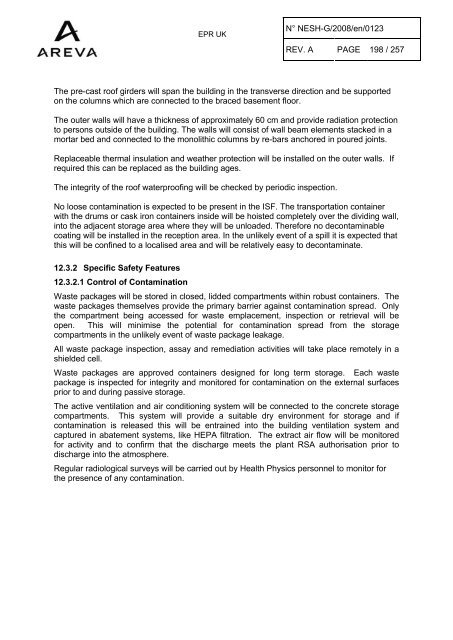Solid Radioactive Waste Strategy Report.pdf - UK EPR
Solid Radioactive Waste Strategy Report.pdf - UK EPR
Solid Radioactive Waste Strategy Report.pdf - UK EPR
Create successful ePaper yourself
Turn your PDF publications into a flip-book with our unique Google optimized e-Paper software.
<strong>EPR</strong> <strong>UK</strong><br />
N° NESH-G/2008/en/0123<br />
REV. A PAGE 198 / 257<br />
The pre-cast roof girders will span the building in the transverse direction and be supported<br />
on the columns which are connected to the braced basement floor.<br />
The outer walls will have a thickness of approximately 60 cm and provide radiation protection<br />
to persons outside of the building. The walls will consist of wall beam elements stacked in a<br />
mortar bed and connected to the monolithic columns by re-bars anchored in poured joints.<br />
Replaceable thermal insulation and weather protection will be installed on the outer walls. If<br />
required this can be replaced as the building ages.<br />
The integrity of the roof waterproofing will be checked by periodic inspection.<br />
No loose contamination is expected to be present in the ISF. The transportation container<br />
with the drums or cask iron containers inside will be hoisted completely over the dividing wall,<br />
into the adjacent storage area where they will be unloaded. Therefore no decontaminable<br />
coating will be installed in the reception area. In the unlikely event of a spill it is expected that<br />
this will be confined to a localised area and will be relatively easy to decontaminate.<br />
12.3.2 Specific Safety Features<br />
12.3.2.1 Control of Contamination<br />
<strong>Waste</strong> packages will be stored in closed, lidded compartments within robust containers. The<br />
waste packages themselves provide the primary barrier against contamination spread. Only<br />
the compartment being accessed for waste emplacement, inspection or retrieval will be<br />
open. This will minimise the potential for contamination spread from the storage<br />
compartments in the unlikely event of waste package leakage.<br />
All waste package inspection, assay and remediation activities will take place remotely in a<br />
shielded cell.<br />
<strong>Waste</strong> packages are approved containers designed for long term storage. Each waste<br />
package is inspected for integrity and monitored for contamination on the external surfaces<br />
prior to and during passive storage.<br />
The active ventilation and air conditioning system will be connected to the concrete storage<br />
compartments. This system will provide a suitable dry environment for storage and if<br />
contamination is released this will be entrained into the building ventilation system and<br />
captured in abatement systems, like HEPA filtration. The extract air flow will be monitored<br />
for activity and to confirm that the discharge meets the plant RSA authorisation prior to<br />
discharge into the atmosphere.<br />
Regular radiological surveys will be carried out by Health Physics personnel to monitor for<br />
the presence of any contamination.

















